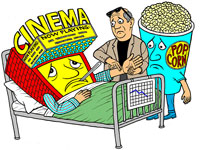| The
Hollywood Economist
The numbers behind the industry.
Once
upon a time, the movie studios and the movie theaters were
in the same business. The studios made films for theater
chains that they either owned or controlled and they harvested
almost all of their revenue from ticket sales. Then, in
1948, the government forced the studios to divest themselves
of the theaters. Nowadays, the two are in very different
businesses. Theater chains, in fact, are in three different
businesses.
First,
they are in the fast food business, selling popcorn, soda,
and other snacks. This is an extremely profitable operation
in which the theaters do not split the proceeds with the
studios (as they do with ticket sales). Popcorn, for example,
because of the immense amount of popped bulk produced from
a relatively small amount of kernels--the ratio is as high
as 60:1--yields more than 90 cents of profit on every dollar
of popcorn sold. It also serves to make customers thirsty
for sodas, another high-margin product (supplied to most
theater chains by Coca-Cola, which makes lucrative deals
with theater owners in return for their exclusive “pouring”
of its products.) One theater chain executive went so far
as to describe the cup holder mounted on each seat, which
allows customers to park their soda while returning to the
concession stand for more popcorn, as “the most important
technological innovation since sound.” He also credited
the extra salt added into the buttery topping on popcorn
as the “secret” to extending the popcorn-soda-popcorn cycle
throughout the movie. For this type of business, theater
owners don't benefit from movies with a gripping or complex
plot, since that would keep potential popcorn customers
in their seats. “We are really in the business of people
moving,” Thomas W. Stephenson, Jr., who then headed Hollywood
Theaters, told me. “The more people we move past the popcorn,
the more money we make.”
Second,
theater chains are in the movie exhibition business. Here
they are partners with the studios. Although every deal
is different, the theaters and the studios generally wind
up splitting the take from the box office roughly 50-50.
But, unlike the popcorn bonanza, the theaters' expenses
eat up a large part of their exhibiion share. They pay all
the costs necessary to maintain the auditoriums, which includes
ushers, cleaning staffs, projectionists to keep the movies
in focus, and the regular replacement of projector bulbs
that cost over $1,000 each. The way they can squeeze out
of more profits from this business is to cut expenses to
the bare minimum. Not uncommonly, theater owners delay changing
projector bulbs even if they do not produce the specified
level of brightness on screen. Or, rather than using a separate
projectionist for each film, multiplexes use one projectionist
to service up to eight movies, an economy of scale that
saves seven salaries. While these projectionists are able
to change reels for one film while other movies go unattended,
this practice runs the risk that the other films might momentarily
snag in the projector and get burnt by the lamp. To prevent
such costly mishaps, projectionists slightly expand the
gap between the gate that supports the film and the lamp,
even though this puts a film slightly out of focus. This
is often considered an acceptable trade-off to the financially-pressed
chains. “I've never heard a teenager complain about PQ [picture
quality],” one movie chain executive said. “If they find
it too dark, they still have the concession stand.”
Third,
the theaters are in the advertising business. They sell
on-screen ads. And some advertisers are paying over $50,000
per screen annually, especially to theaters willing to pump
up the volume to near ear-shattering level so that seated
customers will pay attention. Since there are virtually
no costs involved in showing ads, the proceeds go directly
to the theater chains' bottom line. But to fit paid advertising
into the gap between showings, multiplexes have to cut down
on the length of the studios' coming attractions (which
are free advertising), a decision that hardly pleases studios.
(Often, getting the coming attractions shown involves the
studios “leveraging our goodwill,” as one studio executive
explained. The studios will threaten to hold back a popcorn
movie, such as the new Harry Potter or Star War sequels,
unless the chain agrees to play a full reel of trailers.)
To
keep their people-moving enterprise going, theater owners
prefer movies whose length does not exceeds 128 minutes.
If a movie runs longer than that, and the theater owners
do not want to sacrifice their on-screen advertising time,
they will reduces the number of their evening audience “turns”
or showings from three to two, which means that 33 percent
fewer people pass their popcorn stands. Even so, if a long
movie promises to bring in a big enough audience--a promise
King Kong made but did not deliver--the theatres
will play them. Indeed, the ultimate test for the popcorn
economy is: Will a movie attract enough consumers of buckets
of popcorn and soda to justify turning over multiple screens
to it? Theater owners know that the popcorn audience is
mainly teens. And, since the observation of teen test audiences
over many years has demonstrated that they prefer action
to dialogue, expect a salty, supersize portion of amusement-park
movies this year.
[back to archive]
|



